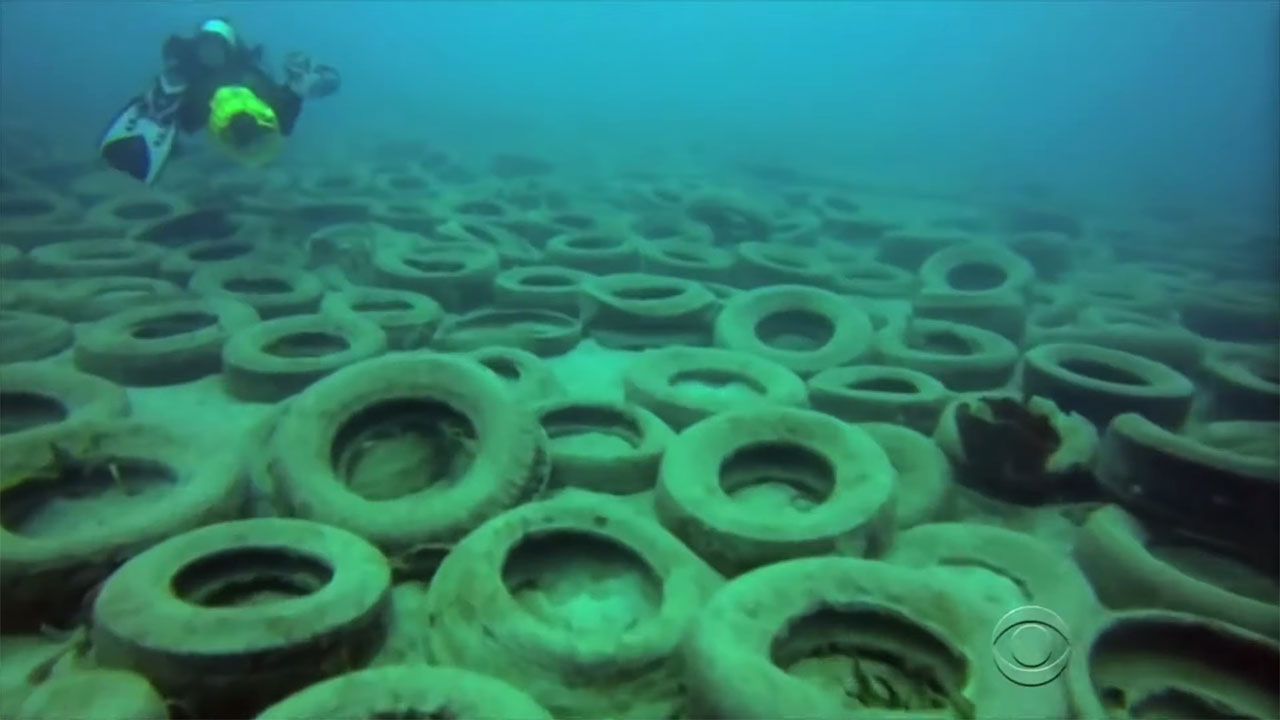
In the 1970s, a well-intentioned initiative to bolster declining reef ecosystems and support fishing industries in Florida took a disastrous turn. A nonprofit organization dumped 2 million tires into the Atlantic Ocean off the state’s southeastern coast, hoping to create artificial reefs and provide habitat for marine life. This ambitious project, known as the Osborne Chain, aimed to repurpose waste tires for environmental benefit. However, by the early 2000s, it had become clear that the project had backfired dramatically, causing significant harm to the very environment it sought to help. The long-term ecosystem consequences of this failed initiative are still being assessed as recently as 2025.
The Birth of the Tire Reef Concept
During the 1970s, Florida’s natural reefs were in decline, prompting the search for innovative solutions to restore these vital habitats. The nonprofit organization behind the Osborne Chain saw potential in repurposing waste materials, specifically 2 million tires, to create artificial structures that could support marine life. The idea was not only cost-effective but also seemed to offer a promising way to enhance marine biodiversity off the southeastern coast of Florida.
Local authorities and fishing communities initially endorsed the project, viewing the tire reefs as a novel approach to environmental restoration. The concept was simple: by providing new structures in the ocean, the tires would attract fish and other sea creatures, creating thriving artificial reefs and boosting local fishing industries.
Planning and Execution of the Dumping
The logistics of the project were complex. The nonprofit had to collect and transport the 2 million tires from various sources across Florida to the dumping site in the Atlantic Ocean. The chosen location for the Osborne Chain was a 52-acre site approximately 2 miles off Fort Lauderdale, selected for its proximity to existing reefs and potential for fish aggregation.
The dumping process took place between 1972 and 1979. The tires were bundled together and dropped in chains to mimic the formations of natural reefs. The hope was that these artificial structures would integrate into the marine environment and provide a new home for a variety of sea life.
Initial Hopes for Marine Benefits
Project backers were optimistic about the potential benefits of the tire reefs. They anticipated that the structures would attract a diverse range of marine life, leading to the formation of thriving artificial reefs in Florida’s coastal waters. In the late 1970s and early 1980s, some initial fish activity around the tire structures seemed to validate these expectations, fueling beliefs that the 2 million tires were successfully aiding the ecosystem.
The nonprofit organization promoted the project as an eco-friendly recycling initiative, garnering media attention for its dual approach to addressing waste disposal and habitat loss. However, despite these early signs of success, problems soon began to emerge.
Early Signs of Failure
By the 1980s, the structural integrity of the tire reefs began to falter. Ocean currents and wave action caused the tires to break free from their bundles and drift away from the intended site. Many of these rogue tires washed up on beaches, creating hazards for swimmers and boats in the Fort Lauderdale area.
Local residents and environmentalists also raised concerns about the tires leaching chemicals into the water. This was a direct contradiction to the project’s original goal to “help” fish and other marine life. The tire reefs, instead of providing a safe habitat, were introducing potentially harmful substances into the ocean.
The Escalating Environmental Nightmare
By 2007, the situation had escalated into a full-blown environmental crisis. The tire reefs had become a nightmare, with scattered debris entangling marine animals like whales, dolphins, and sea turtles. The degrading tires were also releasing heavy metals and microplastics into the ocean, contaminating sediments and food chains in the Atlantic site.
Florida authorities finally acknowledged the failure of the project and initiated studies to assess the full extent of the damage to local biodiversity. The once-promising initiative had turned into a disastrous mistake, with far-reaching consequences for the marine ecosystem.
Long-Term Ecosystem Impacts
Recent assessments in 2025 have revealed persistent ecosystem consequences from the tire dumping. These include reduced coral growth and altered fish populations around the original dumping zone. The remaining tires continue to break down and pollute the water, affecting water quality in Florida’s southeastern Atlantic waters decades after the initial dumping.
The biodiversity losses have been significant, with declines in species diversity compared to nearby natural reefs. This underscores the fact that the artificial tire structures disrupted rather than enhanced marine habitats. The long-term impacts of the Osborne Chain project serve as a stark reminder of the potential risks of well-intentioned but poorly executed environmental initiatives.
Efforts to Remove and Restore
Since the early 2000s, efforts have been underway to clean up the mess left by the Osborne Chain project. Divers and vessels have been tasked with retrieving thousands of tires from the ocean floor near Fort Lauderdale. However, the removal process has been fraught with challenges, including the tires’ entanglement with marine life and the high costs borne by state and federal agencies in Florida.
Despite these challenges, the cleanup operations continue, serving as a stark reminder of the failed experiment with 2 million tires. The lessons learned from this project will undoubtedly influence future artificial reef initiatives, emphasizing the need for durable, environmentally friendly materials over recycled tires.
More from MorningOverview